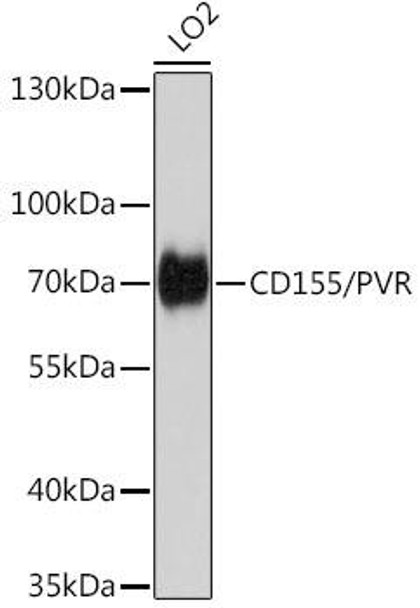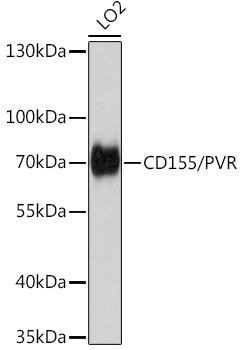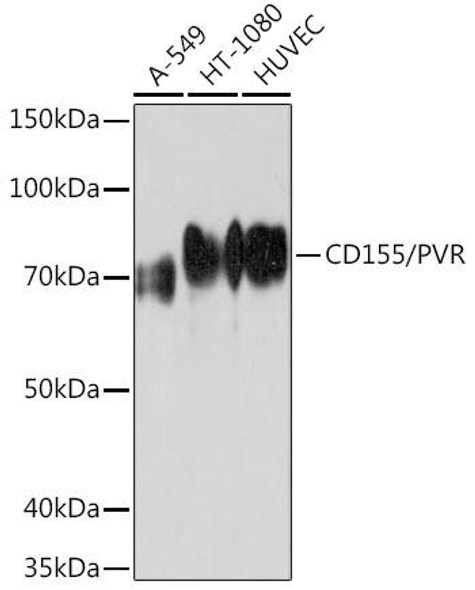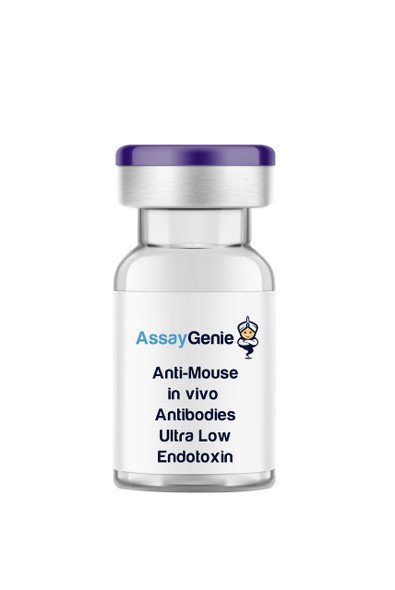Anti-CD155/PVR Antibody (CAB5753)
- SKU:
- CAB5753
- Product type:
- Antibody
- Reactivity:
- Human
- Mouse
- Host Species:
- Rabbit
- Isotype:
- IgG
- Antibody Type:
- Polyclonal Antibody
- Research Area:
- Cell Biology
Description
| Antibody Name: | Anti-CD155/PVR Antibody |
| Antibody SKU: | CAB5753 |
| Antibody Size: | 20uL, 50uL, 100uL |
| Application: | WB IF |
| Reactivity: | Human, Mouse |
| Host Species: | Rabbit |
| Immunogen: | Recombinant fusion protein containing a sequence corresponding to amino acids 220-345 of human CD155/PVR (NP_006496.4). |
| Application: | WB IF |
| Recommended Dilution: | WB 1:500 - 1:2000 IF 1:50 - 1:200 |
| Reactivity: | Human, Mouse |
| Positive Samples: | LO2 |
| Immunogen: | Recombinant fusion protein containing a sequence corresponding to amino acids 220-345 of human CD155/PVR (NP_006496.4). |
| Purification Method: | Affinity purification |
| Storage Buffer: | Store at -20°C. Avoid freeze / thaw cycles. Buffer: PBS with 0.02% sodium azide, 50% glycerol, pH7.3. |
| Isotype: | IgG |
| Sequence: | TCKV EHES FEKP QLLT VNLT VYYP PEVS ISGY DNNW YLGQ NEAT LTCD ARSN PEPT GYNW STTM GPLP PFAV AQGA QLLI RPVD KPIN TTLI CNVT NALG ARQA ELTV QVKE GPPS EHSG MSRN AI |
| Gene ID: | 5817 |
| Uniprot: | P15151 |
| Cellular Location: | Cell membrane, Secreted, Single-pass type I membrane protein |
| Calculated MW: | 39kDa/40kDa/42kDa/45kDa |
| Observed MW: | 70kDa |
| Synonyms: | PVR, CD155, HVED, NECL5, Necl-5, PVS, TAGE4 |
| Background: | The protein encoded by this gene is a transmembrane glycoprotein belonging to the immunoglobulin superfamily. The external domain mediates cell attachment to the extracellular matrix molecule vitronectin, while its intracellular domain interacts with the dynein light chain Tctex-1/DYNLT1. The gene is specific to the primate lineage, and serves as a cellular receptor for poliovirus in the first step of poliovirus replication. Multiple transcript variants encoding different isoforms have been found for this gene. |
| UniProt Protein Function: | PVR: Mediates NK cell adhesion and triggers NK cell effector functions. Binds two different NK cell receptors: CD96 and CD226. These interactions accumulates at the cell-cell contact site, leading to the formation of a mature immunological synapse between NK cell and target cell. This may trigger adhesion and secretion of lytic granules and IFN-gamma and activate cytoxicity of activated NK cells. May also promote NK cell-target cell modular exchange, and PVR transfer to the NK cell. This transfer is more important in some tumor cells expressing a lot of PVR, and may trigger fratricide NK cell activation, providing tumors with a mechanism of immunoevasion. Plays a role in mediating tumor cell invasion and migration. Serves as a receptor for poliovirus attachment to target cells. May play a role in axonal transport of poliovirus, by targeting virion-PVR-containing endocytic vesicles to the microtubular network through interaction with DYNLT1. This interaction would drive the virus-containing vesicle to the axonal retrograde transport. Belongs to the nectin family. 4 isoforms of the human protein are produced by alternative splicing. |
| UniProt Protein Details: | Protein type:Membrane protein, integral; Receptor, misc.; Motility/polarity/chemotaxis; Immunoglobulin superfamily Chromosomal Location of Human Ortholog: 19q13.2 Cellular Component: extracellular space; focal adhesion; cell surface; cytoplasm; integral to membrane; plasma membrane Molecular Function:viral receptor activity; protein binding; receptor activity; cell adhesion molecule binding Biological Process: intercellular junction assembly and maintenance; entry of virus into host cell; cell-cell adhesion; cell migration; regulation of immune response; positive regulation of natural killer cell mediated cytotoxicity directed against tumor cell target; response to virus; susceptibility to natural killer cell mediated cytotoxicity; positive regulation of natural killer cell mediated cytotoxicity |
| NCBI Summary: | The protein encoded by this gene is a transmembrane glycoprotein belonging to the immunoglobulin superfamily. The external domain mediates cell attachment to the extracellular matrix molecule vitronectin, while its intracellular domain interacts with the dynein light chain Tctex-1/DYNLT1. The gene is specific to the primate lineage, and serves as a cellular receptor for poliovirus in the first step of poliovirus replication. Multiple transcript variants encoding different isoforms have been found for this gene. [provided by RefSeq, Oct 2008] |
| UniProt Code: | P15151 |
| NCBI GenInfo Identifier: | 1346922 |
| NCBI Gene ID: | 5817 |
| NCBI Accession: | P15151.2 |
| UniProt Secondary Accession: | P15151,P15152, Q15267, Q15268, Q96BJ1, B4DTS9, |
| UniProt Related Accession: | P15151 |
| Molecular Weight: | Observed MW: 70kDaCalculated MW: 39kDa/40kDa/42kDa/45kDa |
| NCBI Full Name: | Poliovirus receptor |
| NCBI Synonym Full Names: | poliovirus receptor |
| NCBI Official Symbol: | PVR |
| NCBI Official Synonym Symbols: | PVS; HVED; CD155; NECL5; TAGE4; Necl-5 |
| NCBI Protein Information: | poliovirus receptor; nectin-like protein 5 |
| UniProt Protein Name: | Poliovirus receptor |
| UniProt Synonym Protein Names: | Nectin-like protein 5; NECL-5; CD_antigen: CD155 |
| Protein Family: | Poliovirus receptor |
| UniProt Gene Name: | PVR |
| UniProt Entry Name: | PVR_HUMAN |







